2007 CHEVROLET CORVETTE tires
[x] Cancel search: tiresPage 388 of 488
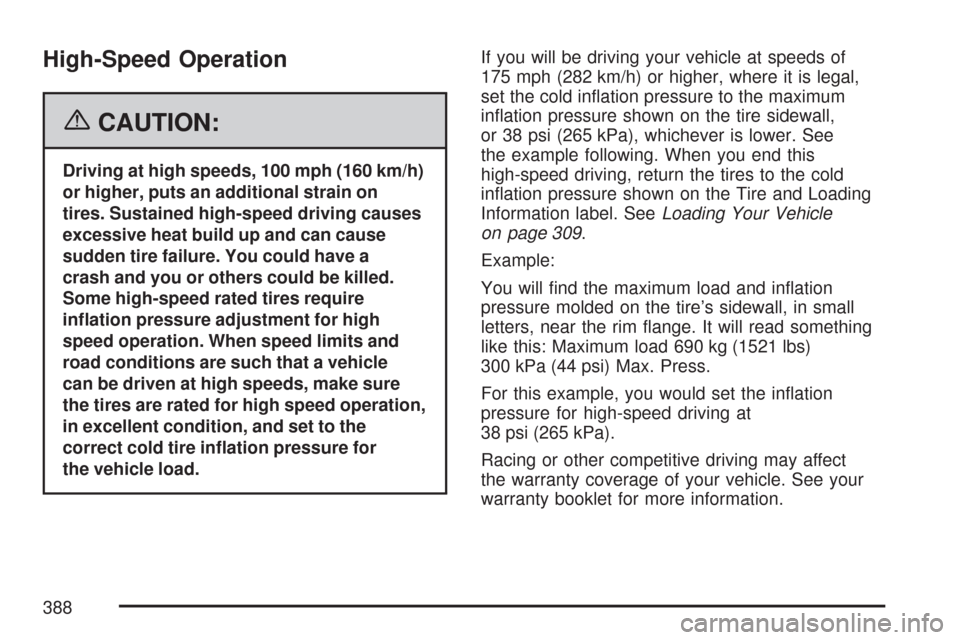
High-Speed Operation
{CAUTION:
Driving at high speeds, 100 mph (160 km/h)
or higher, puts an additional strain on
tires. Sustained high-speed driving causes
excessive heat build up and can cause
sudden tire failure. You could have a
crash and you or others could be killed.
Some high-speed rated tires require
in�ation pressure adjustment for high
speed operation. When speed limits and
road conditions are such that a vehicle
can be driven at high speeds, make sure
the tires are rated for high speed operation,
in excellent condition, and set to the
correct cold tire in�ation pressure for
the vehicle load.If you will be driving your vehicle at speeds of
175 mph (282 km/h) or higher, where it is legal,
set the cold in�ation pressure to the maximum
in�ation pressure shown on the tire sidewall,
or 38 psi (265 kPa), whichever is lower. See
the example following. When you end this
high-speed driving, return the tires to the cold
in�ation pressure shown on the Tire and Loading
Information label. SeeLoading Your Vehicle
on page 309.
Example:
You will �nd the maximum load and in�ation
pressure molded on the tire’s sidewall, in small
letters, near the rim �ange. It will read something
like this: Maximum load 690 kg (1521 lbs)
300 kPa (44 psi) Max. Press.
For this example, you would set the in�ation
pressure for high-speed driving at
38 psi (265 kPa).
Racing or other competitive driving may affect
the warranty coverage of your vehicle. See your
warranty booklet for more information.
388
Page 389 of 488
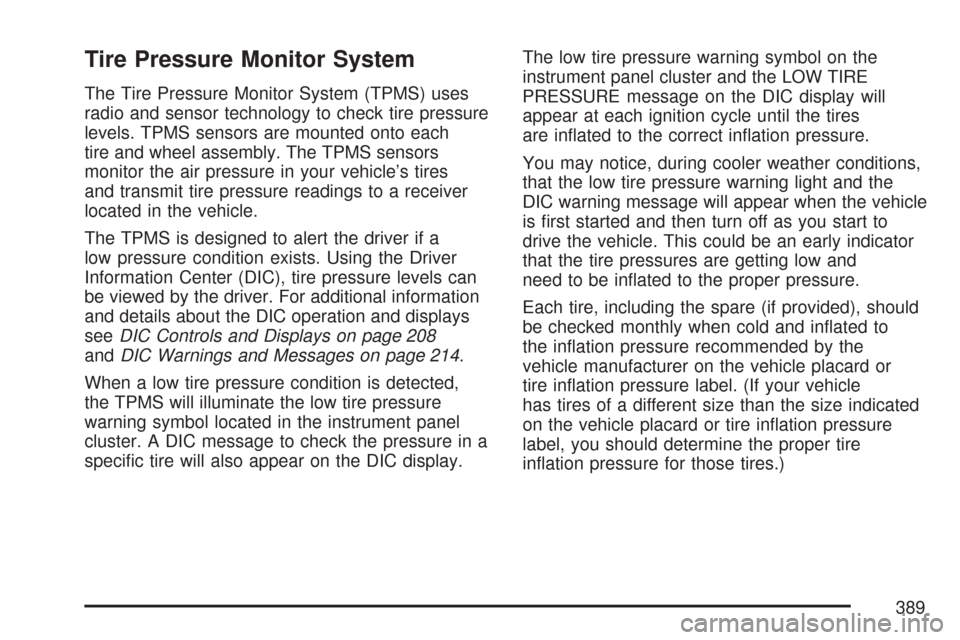
Tire Pressure Monitor System
The Tire Pressure Monitor System (TPMS) uses
radio and sensor technology to check tire pressure
levels. TPMS sensors are mounted onto each
tire and wheel assembly. The TPMS sensors
monitor the air pressure in your vehicle’s tires
and transmit tire pressure readings to a receiver
located in the vehicle.
The TPMS is designed to alert the driver if a
low pressure condition exists. Using the Driver
Information Center (DIC), tire pressure levels can
be viewed by the driver. For additional information
and details about the DIC operation and displays
seeDIC Controls and Displays on page 208
andDIC Warnings and Messages on page 214.
When a low tire pressure condition is detected,
the TPMS will illuminate the low tire pressure
warning symbol located in the instrument panel
cluster. A DIC message to check the pressure in a
speci�c tire will also appear on the DIC display.The low tire pressure warning symbol on the
instrument panel cluster and the LOW TIRE
PRESSURE message on the DIC display will
appear at each ignition cycle until the tires
are in�ated to the correct in�ation pressure.
You may notice, during cooler weather conditions,
that the low tire pressure warning light and the
DIC warning message will appear when the vehicle
is �rst started and then turn off as you start to
drive the vehicle. This could be an early indicator
that the tire pressures are getting low and
need to be in�ated to the proper pressure.
Each tire, including the spare (if provided), should
be checked monthly when cold and in�ated to
the in�ation pressure recommended by the
vehicle manufacturer on the vehicle placard or
tire in�ation pressure label. (If your vehicle
has tires of a different size than the size indicated
on the vehicle placard or tire in�ation pressure
label, you should determine the proper tire
in�ation pressure for those tires.)
389
Page 390 of 488
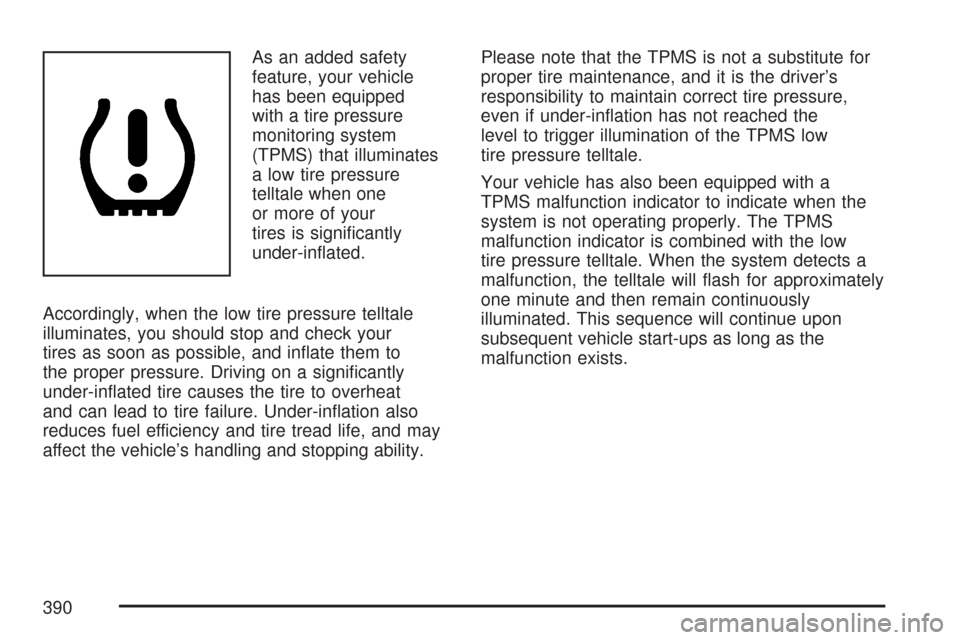
As an added safety
feature, your vehicle
has been equipped
with a tire pressure
monitoring system
(TPMS) that illuminates
a low tire pressure
telltale when one
or more of your
tires is signi�cantly
under-in�ated.
Accordingly, when the low tire pressure telltale
illuminates, you should stop and check your
tires as soon as possible, and in�ate them to
the proper pressure. Driving on a signi�cantly
under-in�ated tire causes the tire to overheat
and can lead to tire failure. Under-in�ation also
reduces fuel efficiency and tire tread life, and may
affect the vehicle’s handling and stopping ability.Please note that the TPMS is not a substitute for
proper tire maintenance, and it is the driver’s
responsibility to maintain correct tire pressure,
even if under-in�ation has not reached the
level to trigger illumination of the TPMS low
tire pressure telltale.
Your vehicle has also been equipped with a
TPMS malfunction indicator to indicate when the
system is not operating properly. The TPMS
malfunction indicator is combined with the low
tire pressure telltale. When the system detects a
malfunction, the telltale will �ash for approximately
one minute and then remain continuously
illuminated. This sequence will continue upon
subsequent vehicle start-ups as long as the
malfunction exists.
390
Page 391 of 488
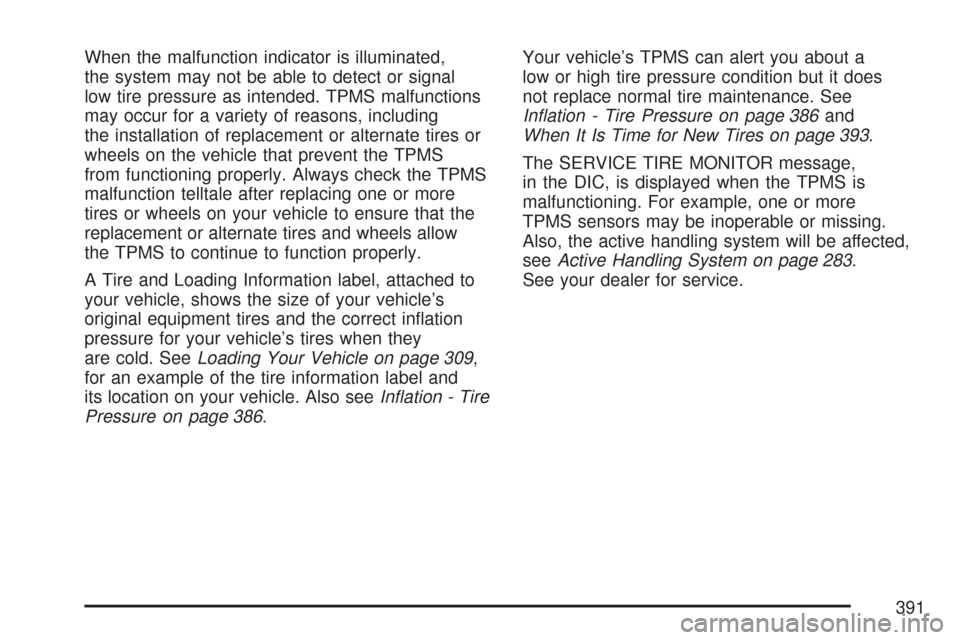
When the malfunction indicator is illuminated,
the system may not be able to detect or signal
low tire pressure as intended. TPMS malfunctions
may occur for a variety of reasons, including
the installation of replacement or alternate tires or
wheels on the vehicle that prevent the TPMS
from functioning properly. Always check the TPMS
malfunction telltale after replacing one or more
tires or wheels on your vehicle to ensure that the
replacement or alternate tires and wheels allow
the TPMS to continue to function properly.
A Tire and Loading Information label, attached to
your vehicle, shows the size of your vehicle’s
original equipment tires and the correct in�ation
pressure for your vehicle’s tires when they
are cold. SeeLoading Your Vehicle on page 309,
for an example of the tire information label and
its location on your vehicle. Also seeIn�ation - Tire
Pressure on page 386.Your vehicle’s TPMS can alert you about a
low or high tire pressure condition but it does
not replace normal tire maintenance. See
In�ation - Tire Pressure on page 386and
When It Is Time for New Tires on page 393.
The SERVICE TIRE MONITOR message,
in the DIC, is displayed when the TPMS is
malfunctioning. For example, one or more
TPMS sensors may be inoperable or missing.
Also, the active handling system will be affected,
seeActive Handling System on page 283.
See your dealer for service.
391
Page 393 of 488
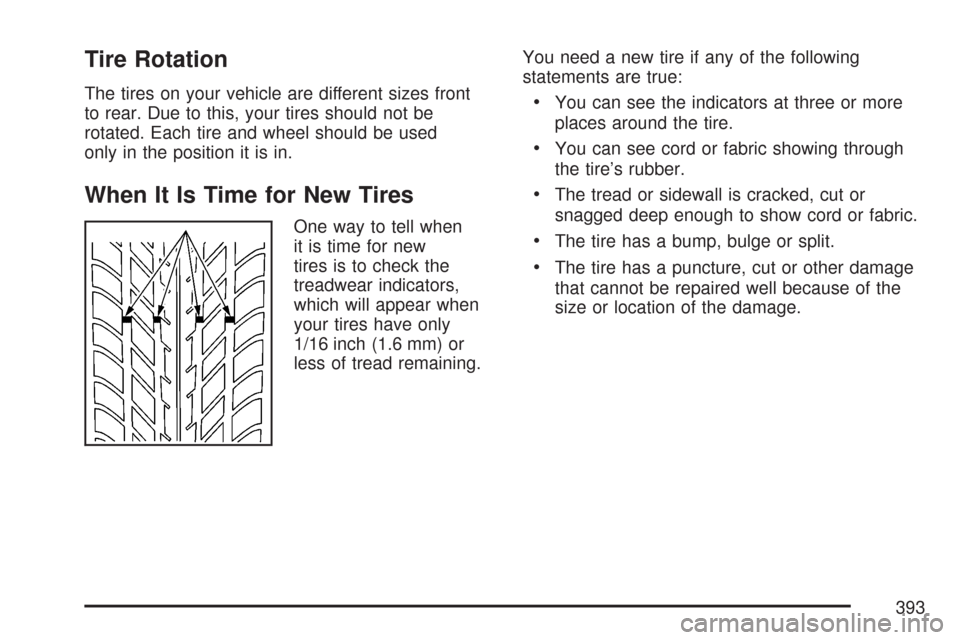
Tire Rotation
The tires on your vehicle are different sizes front
to rear. Due to this, your tires should not be
rotated. Each tire and wheel should be used
only in the position it is in.
When It Is Time for New Tires
One way to tell when
it is time for new
tires is to check the
treadwear indicators,
which will appear when
your tires have only
1/16 inch (1.6 mm) or
less of tread remaining.You need a new tire if any of the following
statements are true:
You can see the indicators at three or more
places around the tire.
You can see cord or fabric showing through
the tire’s rubber.
The tread or sidewall is cracked, cut or
snagged deep enough to show cord or fabric.
The tire has a bump, bulge or split.
The tire has a puncture, cut or other damage
that cannot be repaired well because of the
size or location of the damage.
393
Page 394 of 488
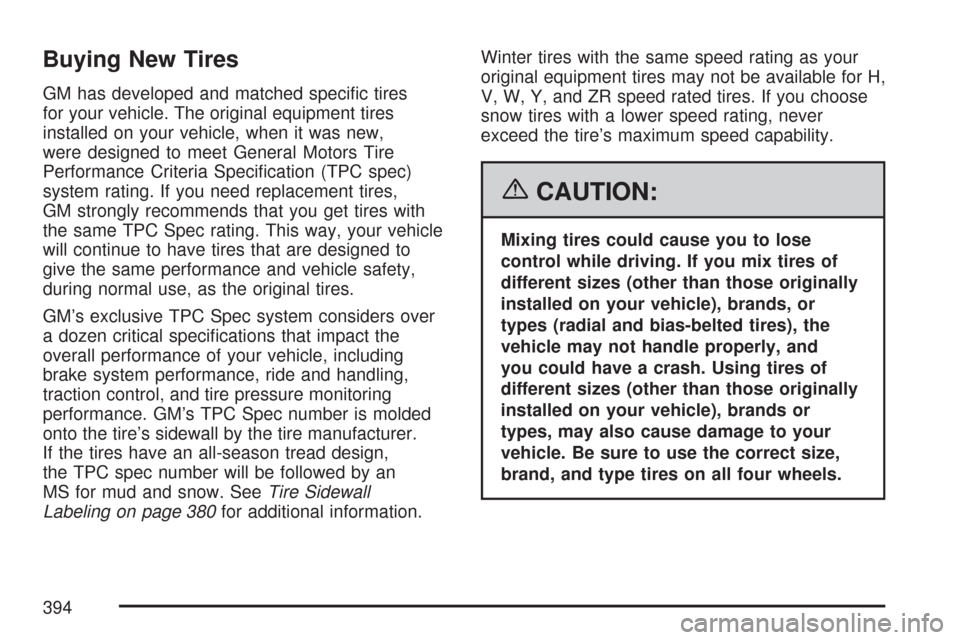
Buying New Tires
GM has developed and matched speci�c tires
for your vehicle. The original equipment tires
installed on your vehicle, when it was new,
were designed to meet General Motors Tire
Performance Criteria Speci�cation (TPC spec)
system rating. If you need replacement tires,
GM strongly recommends that you get tires with
the same TPC Spec rating. This way, your vehicle
will continue to have tires that are designed to
give the same performance and vehicle safety,
during normal use, as the original tires.
GM’s exclusive TPC Spec system considers over
a dozen critical speci�cations that impact the
overall performance of your vehicle, including
brake system performance, ride and handling,
traction control, and tire pressure monitoring
performance. GM’s TPC Spec number is molded
onto the tire’s sidewall by the tire manufacturer.
If the tires have an all-season tread design,
the TPC spec number will be followed by an
MS for mud and snow. SeeTire Sidewall
Labeling on page 380for additional information.Winter tires with the same speed rating as your
original equipment tires may not be available for H,
V, W, Y, and ZR speed rated tires. If you choose
snow tires with a lower speed rating, never
exceed the tire’s maximum speed capability.
{CAUTION:
Mixing tires could cause you to lose
control while driving. If you mix tires of
different sizes (other than those originally
installed on your vehicle), brands, or
types (radial and bias-belted tires), the
vehicle may not handle properly, and
you could have a crash. Using tires of
different sizes (other than those originally
installed on your vehicle), brands or
types, may also cause damage to your
vehicle. Be sure to use the correct size,
brand, and type tires on all four wheels.
394
Page 395 of 488
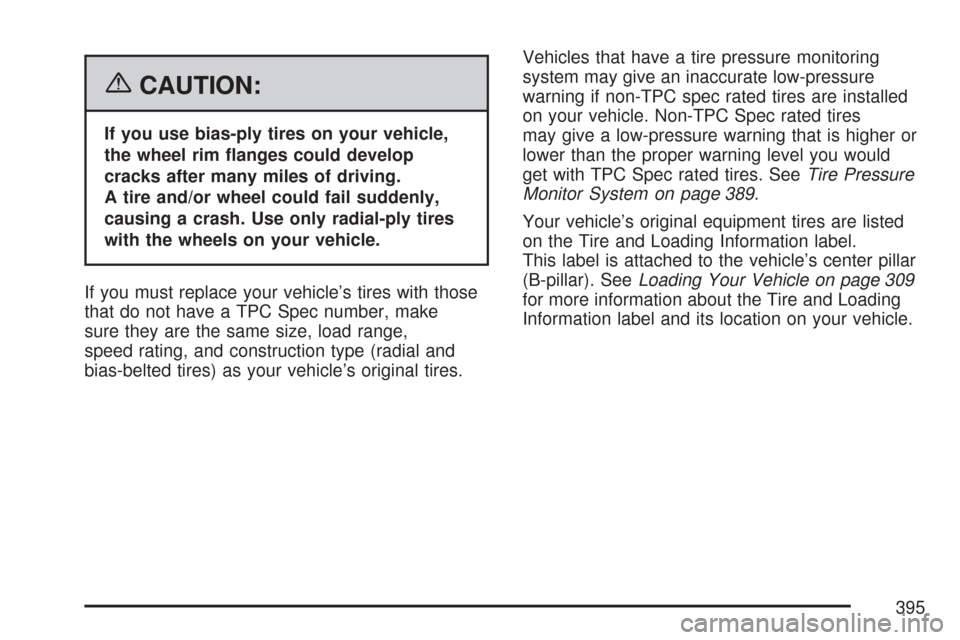
{CAUTION:
If you use bias-ply tires on your vehicle,
the wheel rim �anges could develop
cracks after many miles of driving.
A tire and/or wheel could fail suddenly,
causing a crash. Use only radial-ply tires
with the wheels on your vehicle.
If you must replace your vehicle’s tires with those
that do not have a TPC Spec number, make
sure they are the same size, load range,
speed rating, and construction type (radial and
bias-belted tires) as your vehicle’s original tires.Vehicles that have a tire pressure monitoring
system may give an inaccurate low-pressure
warning if non-TPC spec rated tires are installed
on your vehicle. Non-TPC Spec rated tires
may give a low-pressure warning that is higher or
lower than the proper warning level you would
get with TPC Spec rated tires. SeeTire Pressure
Monitor System on page 389.
Your vehicle’s original equipment tires are listed
on the Tire and Loading Information label.
This label is attached to the vehicle’s center pillar
(B-pillar). SeeLoading Your Vehicle on page 309
for more information about the Tire and Loading
Information label and its location on your vehicle.
395
Page 396 of 488
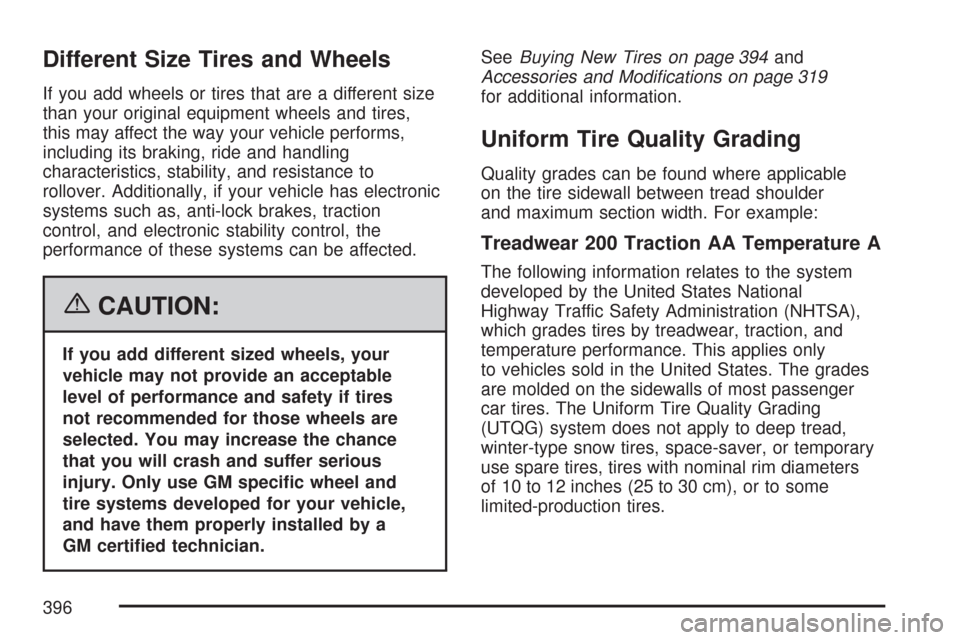
Different Size Tires and Wheels
If you add wheels or tires that are a different size
than your original equipment wheels and tires,
this may affect the way your vehicle performs,
including its braking, ride and handling
characteristics, stability, and resistance to
rollover. Additionally, if your vehicle has electronic
systems such as, anti-lock brakes, traction
control, and electronic stability control, the
performance of these systems can be affected.
{CAUTION:
If you add different sized wheels, your
vehicle may not provide an acceptable
level of performance and safety if tires
not recommended for those wheels are
selected. You may increase the chance
that you will crash and suffer serious
injury. Only use GM speci�c wheel and
tire systems developed for your vehicle,
and have them properly installed by a
GM certi�ed technician.SeeBuying New Tires on page 394and
Accessories and Modi�cations on page 319
for additional information.
Uniform Tire Quality Grading
Quality grades can be found where applicable
on the tire sidewall between tread shoulder
and maximum section width. For example:
Treadwear 200 Traction AA Temperature A
The following information relates to the system
developed by the United States National
Highway Traffic Safety Administration (NHTSA),
which grades tires by treadwear, traction, and
temperature performance. This applies only
to vehicles sold in the United States. The grades
are molded on the sidewalls of most passenger
car tires. The Uniform Tire Quality Grading
(UTQG) system does not apply to deep tread,
winter-type snow tires, space-saver, or temporary
use spare tires, tires with nominal rim diameters
of 10 to 12 inches (25 to 30 cm), or to some
limited-production tires.
396